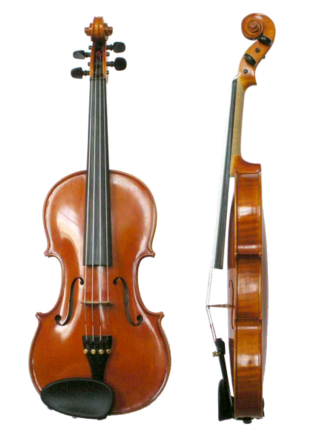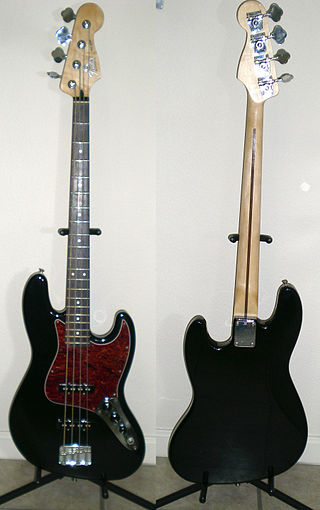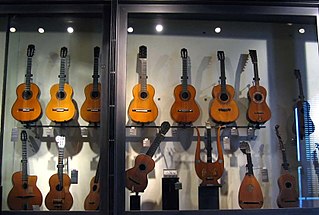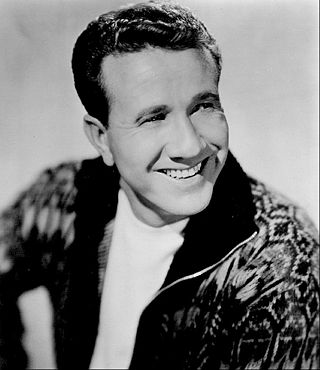
The bass guitar, electric bass or simply bass is the lowest-pitched member of the guitar family. It is a plucked string instrument similar in appearance and construction to an electric or acoustic guitar, but with a longer neck and scale length, and typically four to six strings or courses. Since the mid-1950s, the bass guitar has largely come to replace the double bass in popular music due to its lighter weight, the use of frets and, most importantly, its design for electric amplification.

An effects unit or effects pedal is an electronic device that alters the sound of a musical instrument or other audio source through audio signal processing.

The violin, sometimes known as a fiddle, is a wooden chordophone in the violin family. Most violins have a hollow wooden body. It is the smallest and thus highest-pitched instrument (soprano) in the family in regular use. The violin typically has four strings, usually tuned in perfect fifths with notes G3, D4, A4, E5, and is most commonly played by drawing a bow across its strings. It can also be played by plucking the strings with the fingers (pizzicato) and, in specialized cases, by striking the strings with the wooden side of the bow.

String instruments, stringed instruments, or chordophones are musical instruments that produce sound from vibrating strings when a performer plays or sounds the strings in some manner.

A mute is a device attached to a musical instrument which changes the instrument's tone quality (timbre) or lowers its volume. Mutes are commonly used on string and brass instruments, especially the trumpet and trombone, and are occasionally used on woodwinds. Their effect is mostly intended for artistic use, but they can also allow players to practice discreetly. Muting can also be done by hand, as in the case of palm muting a guitar or grasping a triangle to dampen its sound.

Jean-Luc Ponty is a French jazz and jazz fusion violinist and composer.

The Fender Jazz Bass is the second model of electric bass created by Leo Fender. It is distinct from the Precision Bass in that its tone is brighter and richer in the midrange and treble with less emphasis on the fundamental frequency. The body shape is also different from the Precision Bass, in that the Precision Bass has a symmetrical lower bout on the body, designed after the Telecaster and Stratocaster lines of guitars, while the Jazz Bass has an offset lower bout, mimicking the design aesthetic of the Jaguar and Jazzmaster guitars.

Michał Urbaniak is a Polish jazz musician who plays violin, lyricon, and saxophone. His music includes elements of folk music, rhythm and blues, hip hop, and symphonic music.

The following outline is provided as an overview of and topical guide to guitars:

A bass amplifier is a musical instrument electronic device that uses electrical power to make lower-pitched instruments such as the bass guitar or double bass loud enough to be heard by the performers and audience. Bass amps typically consist of a preamplifier, tone controls, a power amplifier and one or more loudspeakers ("drivers") in a cabinet.
Violectra is the name of a range of electric violins, violas and cellos designed, developed and hand made by David Bruce Johnson, a Canadian violin maker settled in Birmingham, England. These instruments are played by Nigel Kennedy, Richard Tognetti, Stephen Nachmanovitch, Leila Josefowicz and many more professional players worldwide.

Distortion and overdrive are forms of audio signal processing used to alter the sound of amplified electric musical instruments, usually by increasing their gain, producing a "fuzzy", "growling", or "gritty" tone. Distortion is most commonly used with the electric guitar, but may also be used with other electric instruments such as electric bass, electric piano, synthesizer and Hammond organ. Guitarists playing electric blues originally obtained an overdriven sound by turning up their vacuum tube-powered guitar amplifiers to high volumes, which caused the signal to distort. While overdriven tube amps are still used to obtain overdrive, especially in genres like blues and rockabilly, a number of other ways to produce distortion have been developed since the 1960s, such as distortion effect pedals. The growling tone of a distorted electric guitar is a key part of many genres, including blues and many rock music genres, notably hard rock, punk rock, hardcore punk, acid rock, and heavy metal music, while the use of distorted bass has been essential in a genre of hip hop music and alternative hip hop known as "SoundCloud rap".
Electric guitar design is a type of industrial design where the looks and efficiency of the shape as well as the acoustical aspects of the guitar are important factors. In the past many guitars have been designed with various odd shapes as well as very practical and convenient solutions to improve the usability of the object.
The Summit format is used in jazz to bring together performers on a particular musical instrument. Though these recordings often feature other musicians, the main instrument is focused upon in a celebratory way.
BJFE Guitar Effects is a company which manufactures effects pedals for use with instruments such as an electric guitar. These pedals are commonly used by guitarists to modify the sound of their guitar before it reaches the amp. The company is located in Sweden, and was founded in 2000 by Björn Juhl. "BJFE" stands for Björn Juhl Förstärkarelektronik. Pedal types include distortion, overdrive, "vibe" (vibrato), compression, and equalization (EQ). Due to the limited production and handbuilt nature, these pedals are considered "boutique" guitar effects.

Fuzz bass is a style of playing the electric bass or modifying its signal that produces a buzzy, distorted, overdriven sound, as the name implies. Overdriving a bass signal significantly changes the timbre, adds higher overtones (harmonics), increases the sustain, and, if the gain is turned up high enough, creates a "breaking up" sound characterized by a growling, buzzy tone.

Heavy metal bass is the use of the bass guitar in the rock music genres of heavy metal and hard rock. The bassist is part of the rhythm section in a heavy metal band, along with the drummer, rhythm guitarist and, in some bands, a keyboard player. The prominent role of the bass is key to the metal sound, and the interplay of bass and distorted electric guitar is a central element of metal. The bass guitar provides the low-end sound crucial to making the music "heavy". The bass plays a crucial role in heavy metal and a more important role than in traditional rock."

Timothy Gerard Landers is an American bassist best known for his contribution to the 1970s-80s jazz-fusion genre and his work with Al Di Meola, Billy Cobham, and Gil Evans. Landers is a session musician and was a member of Tom Scott's band on The Pat Sajak Show.


















